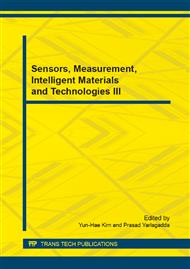p.899
p.904
p.911
p.915
p.921
p.926
p.935
p.941
p.946
The Algorithms of AE Processing for Automated Systems to Measure Rheological
Abstract:
There are the results of the acoustic emission (AE) signals spectrum modification during steel 30XGSA heating near the austenite transformation intervals. It is established in the AE signals spectrum during heating depend on steel phase structure. It makes possible the application of AE method for determination the austenite transformation borders. The critical points of austenite formations and austenite decay are based on heat treatment technologies. It is known, that there are phenomenon of steels properties modification without structure modification not for from phase transformation borders. This was very convenient for detecting the particles with foregone energy characteristics. The automated complex allows one to carry out measurements for a long time using two measuring setups in parallel, which is to study the dynamics of theological and acoustic features of the composition being studied.
Info:
Periodical:
Pages:
921-925
Citation:
Online since:
March 2015
Authors:
Price:
Сopyright:
© 2015 Trans Tech Publications Ltd. All Rights Reserved
Share:
Citation:


